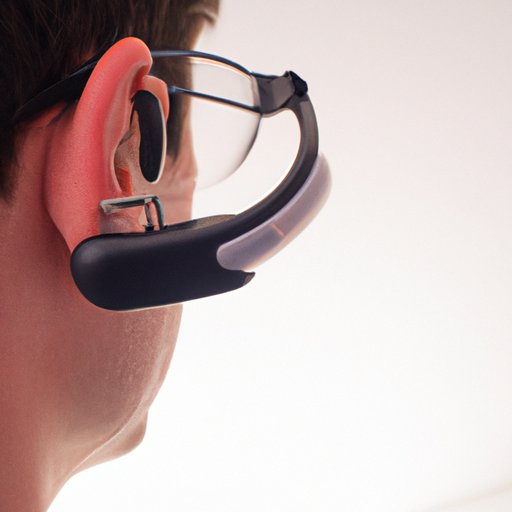Introduction
Bone conduction headphones are a type of headphone that transmits sound through vibration of bones in the skull, rather than through the traditional method of sending sound waves into the ear canal. This technology has become increasingly popular in recent years, as it offers an alternative to traditional headsets while still providing users with high-quality audio. But is this technology safe? In this article, we’ll explore the safety of bone conduction headphones and discuss the pros and cons of using them.

Exploring the Pros and Cons of Bone Conduction Headphones
When it comes to evaluating the safety of bone conduction headphones, it’s important to consider both the advantages and disadvantages of using them. Here’s a look at some of the key points to consider.
Advantages of Bone Conduction Headphones
One of the major advantages of bone conduction headphones is that they provide users with a more comfortable listening experience. Because the sound is transmitted directly to the inner ear, there is no need for uncomfortable earbuds or heavy over-the-ear headphones. Additionally, since the sound is transmitted through the bones of the skull, it can be heard even if the user is wearing a hat or other headgear. This makes them ideal for use in outdoor activities such as running or cycling.
Disadvantages of Bone Conduction Headphones
The main disadvantage of bone conduction headphones is that they are not as powerful as traditional headphones. This means that they may not be suitable for use in loud environments, such as concerts or nightclubs. Additionally, because the sound is transmitted through the bones of the skull, it may be less clear than traditional headphones. This can make it difficult to hear certain sounds, such as bass notes.

How to Use Bone Conduction Headphones Safely
In order to ensure the safe use of bone conduction headphones, it’s important to follow a few guidelines. Here are some tips for using them safely:
Choosing the Right Fit
When choosing a pair of bone conduction headphones, it’s important to make sure that they fit properly. An ill-fitting set of headphones can cause discomfort and may even lead to injury. Make sure that the headphones fit snugly but not too tightly on your head.
Adjusting Volume Settings
It’s also important to adjust the volume settings on your bone conduction headphones to a safe level. A good rule of thumb is to keep the volume at around 60% of the maximum setting. This will help protect your ears from any potential damage caused by loud noises.
Limiting Wear Time
Finally, it’s important to limit the amount of time that you wear your bone conduction headphones. Prolonged exposure to loud noises can lead to permanent hearing damage, so it’s best to take regular breaks from wearing them. If you find that your ears are feeling uncomfortable or strained after wearing them, take a break and give your ears a chance to rest.

The Health Risks Associated with Wearing Bone Conduction Headphones
While bone conduction headphones can provide a comfortable and convenient listening experience, it’s important to be aware of the potential health risks associated with their use. Here are some of the most common risks associated with wearing bone conduction headphones:
Potential Hearing Loss
One of the most serious risks associated with wearing bone conduction headphones is the potential for hearing loss. Prolonged exposure to loud noises can damage the delicate structures of the inner ear, leading to permanent hearing loss. To reduce the risk of hearing loss, it’s important to limit the amount of time you spend wearing your headphones and to keep the volume setting at a safe level.
Risk of Tinnitus
Another potential risk associated with wearing bone conduction headphones is the risk of developing tinnitus. Tinnitus is a condition that causes ringing or buzzing in the ears, and it can be caused by exposure to loud noises. To reduce the risk of tinnitus, it’s important to limit the amount of time you spend wearing your headphones and to keep the volume setting at a safe level.
Impact on Balance
Finally, it’s important to be aware of the potential impact that bone conduction headphones can have on your balance. The vibrations created by the headphones can interfere with the signals sent by your inner ear, which can affect your sense of balance. To reduce the risk of balance problems, it’s important to limit the amount of time you spend wearing your headphones and to take regular breaks from wearing them.
Understanding the Technology Behind Bone Conduction Headphones
In order to fully understand the safety of bone conduction headphones, it’s important to understand the technology behind them. Here’s a look at how bone conduction headphones work and the different types available:
How Bone Conduction Headphones Work
Bone conduction headphones use vibrations to transmit sound directly to the inner ear. When the headphones are placed on the head, the vibrations travel through the bones of the skull and into the inner ear. This eliminates the need for traditional earbuds or over-the-ear headphones, and it also allows users to hear the sound even if they’re wearing hats or other headgear.
Types of Bone Conduction Headphones
There are two main types of bone conduction headphones: open-ear and closed-ear. Open-ear headphones allow sound to escape from the headphones and be heard by others nearby, while closed-ear headphones completely enclose the ear and prevent sound from escaping. It’s important to choose the right type of headphones for your needs, as each type has its own benefits and drawbacks.
Conclusion
Bone conduction headphones offer a comfortable and convenient way to listen to music and other audio. However, it’s important to understand the potential risks associated with their use and to use them safely. By following the tips outlined above, you can ensure that you get the most out of your bone conduction headphones without compromising your safety or health.


